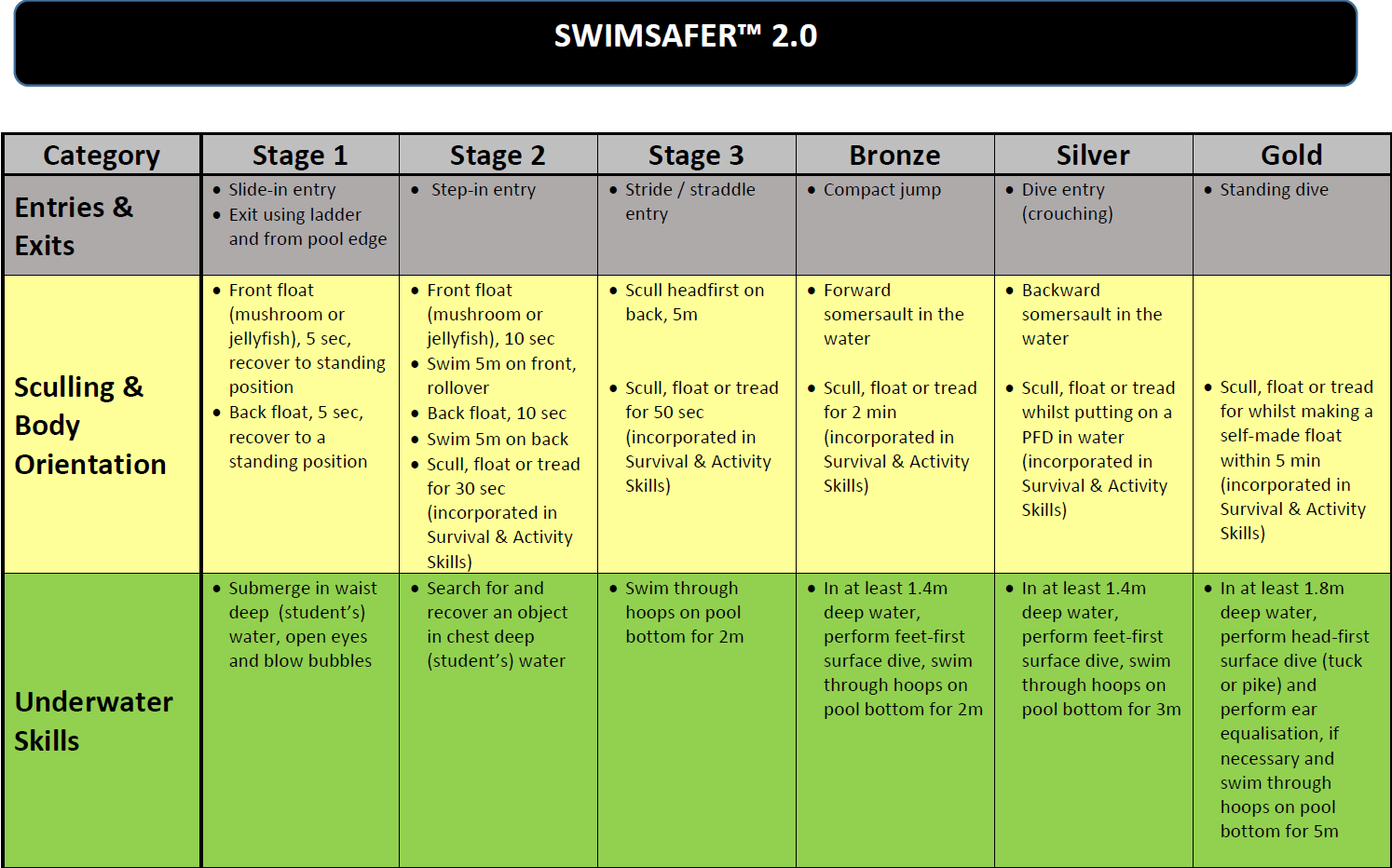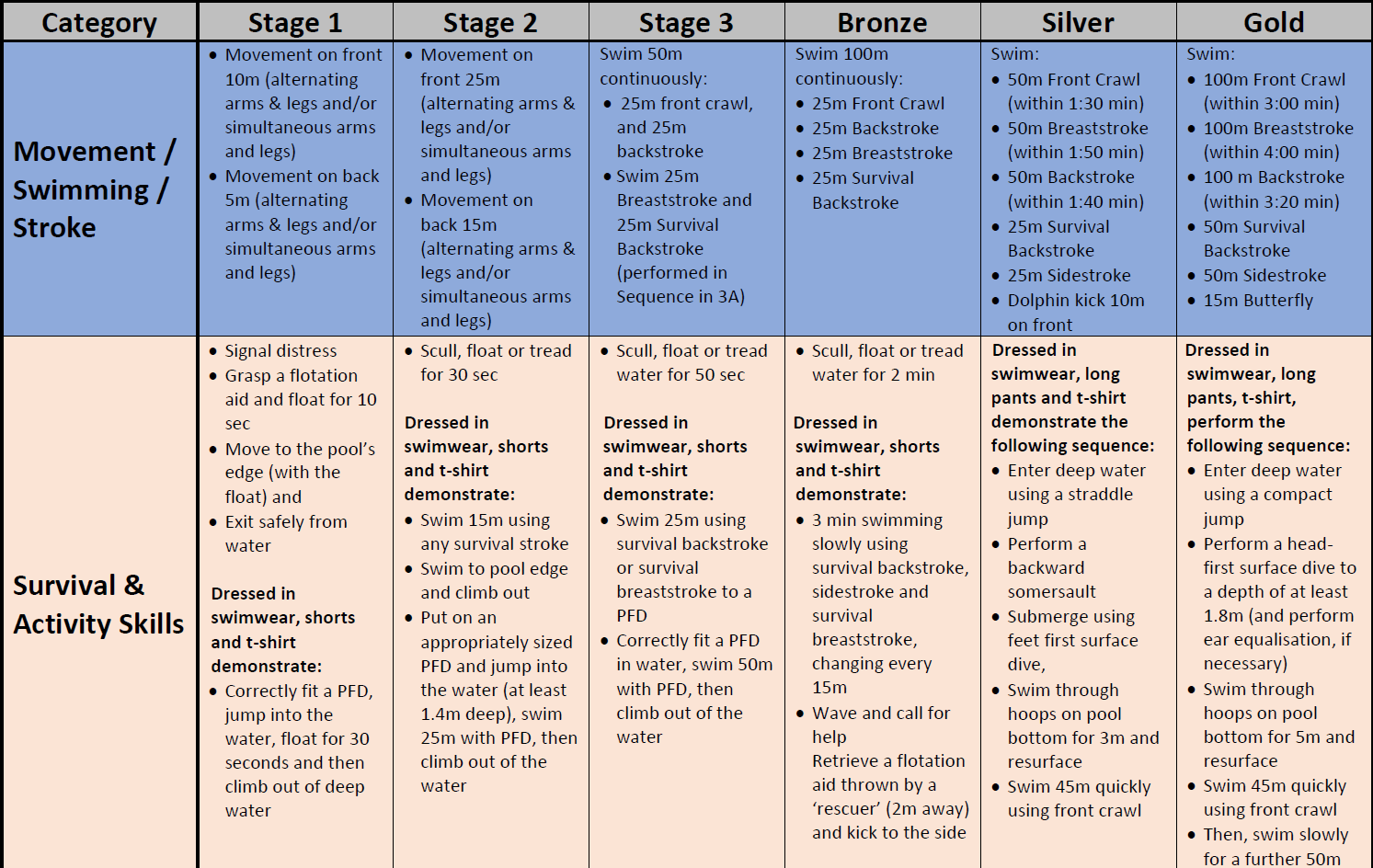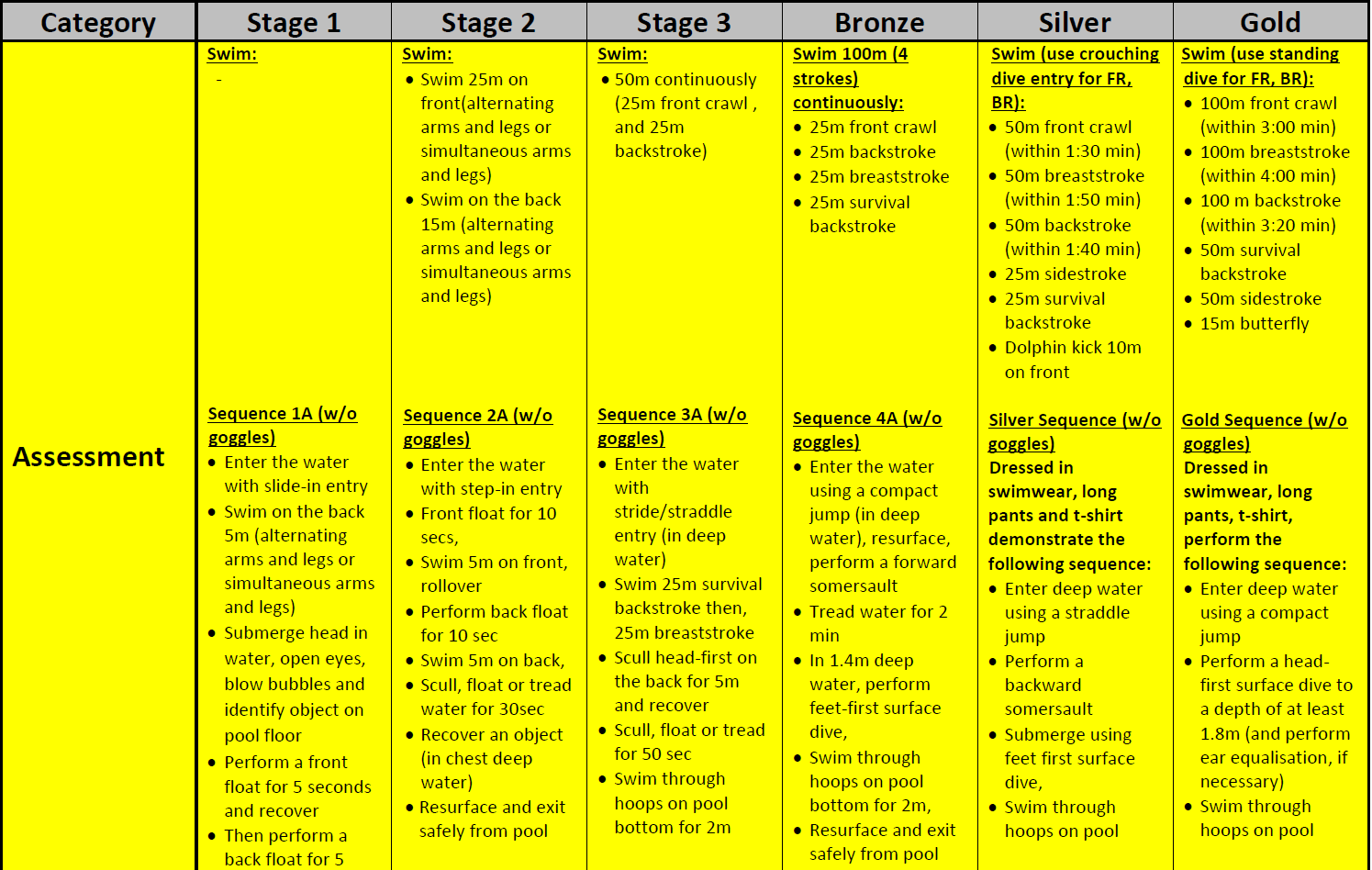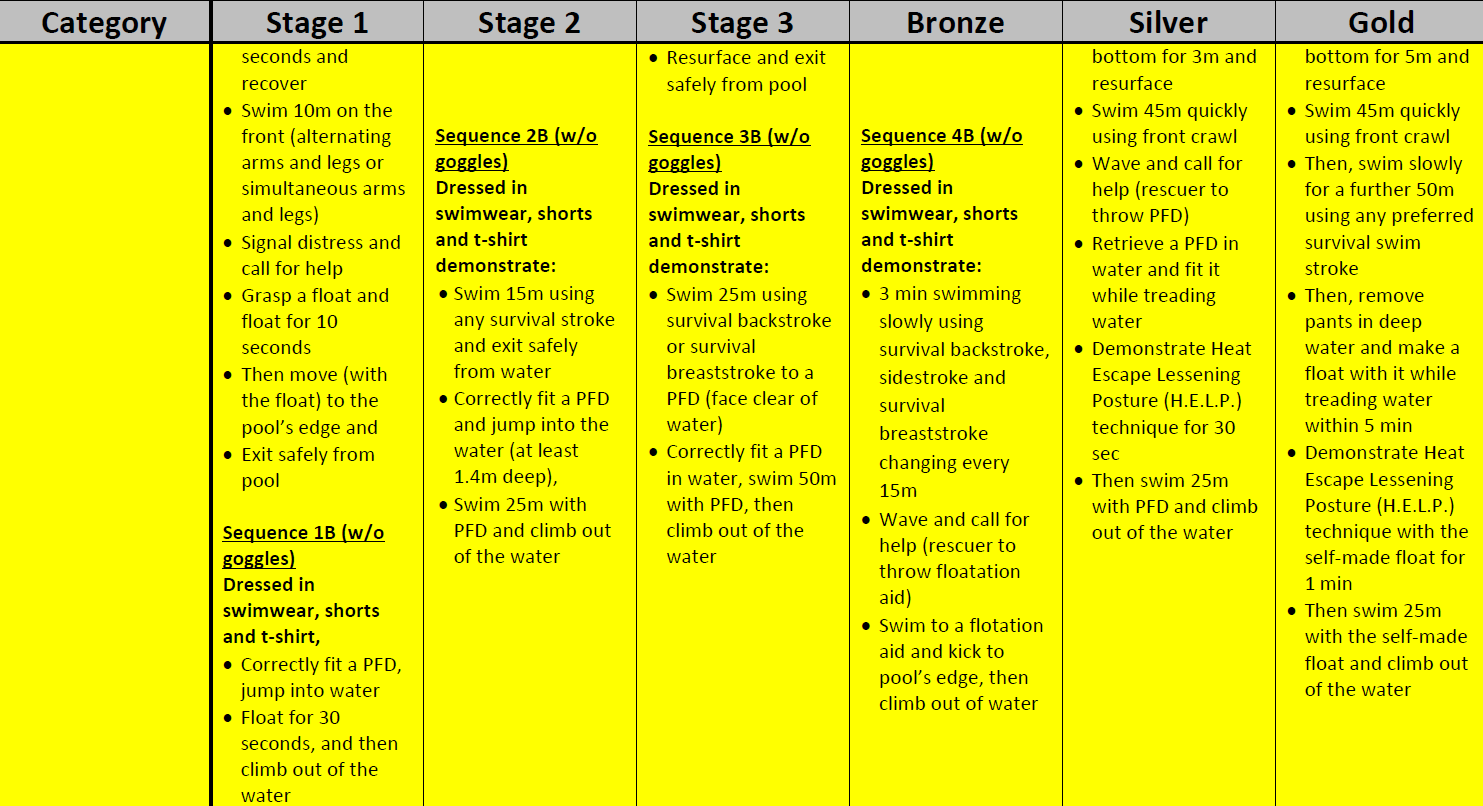
STAGE 1
Swim: Incorporated in Sequence 1A
Sequence 1A: (with or w/o goggles)
- Enter the water with slide-in entry
- Swim on the back 5m (alternating arms & legs or simultaneous arms and legs)
- Submerge head in water, open eyes, blow bubbles and identify object on pool floor (w/o goggles)
- Perform a front float for 5 seconds and stand to recover
- Then perform a back float for 5 seconds and stand to recover
- Swim 10m (alternating arm and leg action on front or simultaneous arm and leg action on front)
- Signal distress and call for help (w/o goggles)
- Grasp the float and float for 10 seconds (w/o goggles)
- Then move (with the float) to the pool’s edge and
- Exit safely from pool (either by ladder or pool’s edge)
Sequence 1B: (w/o goggles)
Dressed in swimwear, shorts and t-shirt,
- Correctly fit a PFD (assistance allowed)
- Jump in with PFD to water and float for 30 seconds, and then climb out of the water
STAGE 2
Swim:
- Swim on the front 25m (alternating arms & legs or simultaneous arms and legs)
- Swim on the back 15m (alternating arms & legs or simultaneous arms and legs)
Survival Sequence 2A: (w/o goggles)
- Enter the water with step-in entry
- Front float for 10 seconds
- Swim 5m on front, rollover
- Perform back float for 10 seconds
- Swim 5m on back
- Scull, float or tread water for 30 seconds
- Recover an object (in chest deep water)
- Resurface and exit safely from pool
Survival Sequence 2B part 1: (w/o goggles)
Dressed in swimwear, shorts and t-shirt demonstrate:
- Swim 15m using any survival stroke (face clear of water) and exit safely from water
Survival Sequence 2B part 2: (w/o goggles)
- Correctly fit a PFD and jump into the water (at least 1.4m deep), swim 25m with PFD, then climb out of the water
STAGE 3
Swim 50m continuously:
- 25m backstroke, and
- 25m front crawl
Survival Sequence 3A (w/o goggles):
- Enter the water with stride/straddle entry (in deep water)
- Swim 25m survival backstroke then, 25m breaststroke
- Scull head-first on the back for 5m and recover
- Scull, float or tread for another 50 seconds
- Swim through hoops on pool bottom for 2m swim
- Resurface and exit safely from pool
Survival Sequence 3B (w/o goggles):
Dressed in swimwear, shorts and t-shirt demonstrate:
- Swim 25m using survival backstroke or survival breaststroke to a PFD (Face clear of water)
- Correctly fit a PFD in water, swim 50m with PFD, then climb out of the water
STAGE 4 (Bronze)
Swim:
Swim 100m continuously:
- 25m Front-Crawl
- 25m Backstroke
- 25m Breaststroke
- 25m Survival Backstroke
Survival Sequence Bronze A (w/o goggles):
- Enter the water using a compact jump (in deep water), resurface
- Perform a forward somersault
- Scull, float or tread water for 2 min
- In at least 1.4m deep water, perform feet-first surface dive
- Swim through hoops on pool bottom for 2m
- Resurface and exit safely from pool
Survival Sequence Bronze B: (w/o goggles)
Dressed in swimwear, shorts and t-shirt demonstrate:
- 3 min swimming slowly using survival backstroke, sidestroke, survival breaststroke, change stroke at every 15m mark
- Wave for help (rescuer to throw flotation aid)
- Swim to a flotation aid and kick to pool’s edge, then climb out of water
STAGE 5 (Silver)
Swim:
Swim (use crouching dive entry for Front-Crawl, Breaststroke):
- 50m Front-Crawl (within 1:30 min)
- 50m Breaststroke (within 1:50 min)
- 50m Backstroke (within 1:40 min)
- 25m Survival Backstroke
- 25m Sidestroke
- Dolphin kick 10m on front
Silver Sequence: (w/o goggles)
Dressed in swimwear, long pants and t-shirt demonstrate the following sequence:
- Enter deep water using a straddle jump
- Perform a backward somersault
- Submerge using feet first surface dive
- Swim through hoops on pool bottom for 3m and resurface
- Swim 45m quickly using front crawl
- Wave and call for help (rescuer to throw a PFD)
- Retrieve a PFD in water and fit it while treading water.
- Demonstrate Heat Escape Lessening Posture (H.E.L.P.) technique for 30 seconds
- Then swim 25m with PFD and climb out of the water
STAGE 6 (Gold)
Swim:
Swim (use standing dive entry for Front-Crawl, Breaststroke):
- 100m Front-Crawl (within 3:00 min)
- 100m Breaststroke (within 4:00 min)
- 100m Backstroke (within 3:20 min)
- 50m Survival Backstroke
- 50m Sidestroke
- 15m Butterfly
Gold Sequence : (w/o goggles)
Dressed in swimwear, long pants, t-shirt, perform the following sequence
- Enter deep water using a compact jump
- Perform a head-first surface dive to a depth of at least 1.8m (and perform ear equalisation, if necessary)
- Swim through hoops on pool bottom for 5m and resurface
- Swim 45m quickly using front crawl
- Then, swim slowly for a further 50m using any preferred survival swim stroke (Face clear of water). Remove pants in deep water and make a float with it while treading water within 5 min.
- Demonstrate Heat Escape Lessening Posture (H.E.L.P.) technique for 1 min with the self-made float
- Then swim 25m with the self-made float
- Climb out of the water
WATER SAFETY KNOWLEDGE - Principles of Personal safety and Survival
A. PRINCIPLES OF PERSONAL SAFETY AND SURVIVAL
- designed to keep a conscious person afloat in calm conditions
- has less buoyancy
- floatation material is on the back of the device
- designed to turn an unconscious person from face down to face up in the water, allowing them to breathe
- has more buoyancy
- floatation material is in the front of the device
WATER SAFETY KNOWLEDGE - Rescue
D. RESCUE
- Awareness
- Assessment
- Action
- Aftercare
With a floatation aid, swim to the victim and pass the aid to him or her. Accompany the person to safety.
Rescuers should use a swimming rescue only if he/she is a strong/confident swimmer and when all land-based rescues have either failed or are not appropriate.
Swim closer to the victim and use an assist equipment to tow the victim to safety.
If a swimming rescue is to be used, always attempt an Accompanied Swimming rescue first. However, a Non-contact Tow can be used when an accompanied rescue is not possible or has proven ineffective.
Swim to the victim to tow him or her to safety.
A Contact Tow is performed when all other rescue approaches are not suitable. For example, when the victim is not able to swim, has not responded to rescue aids, or is unconscious.





